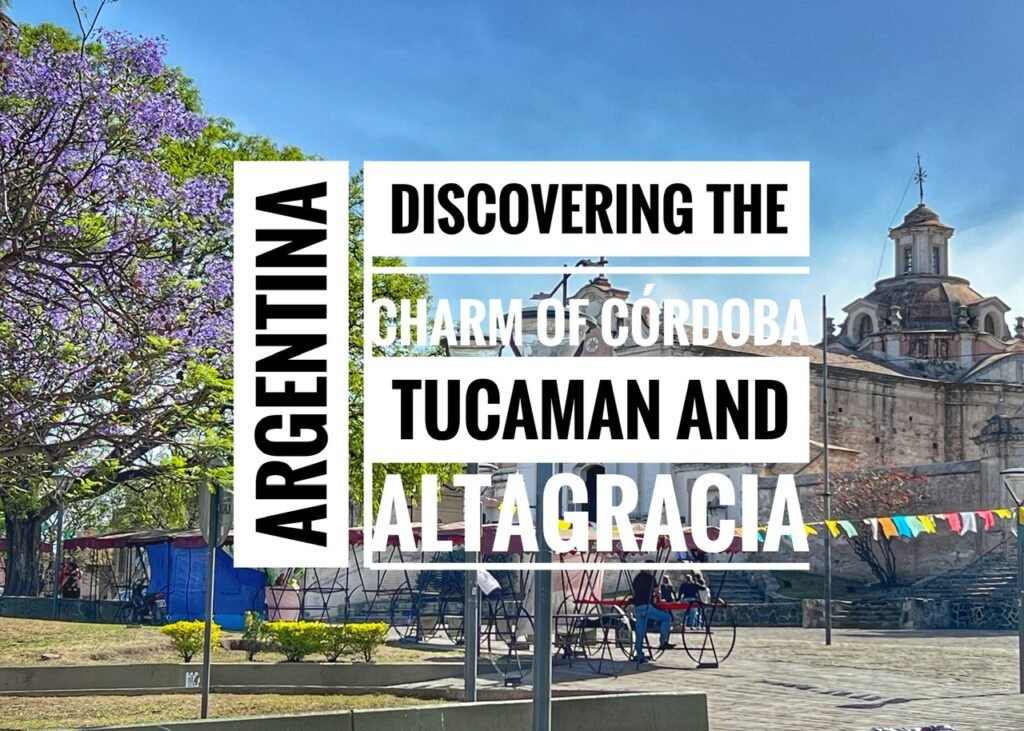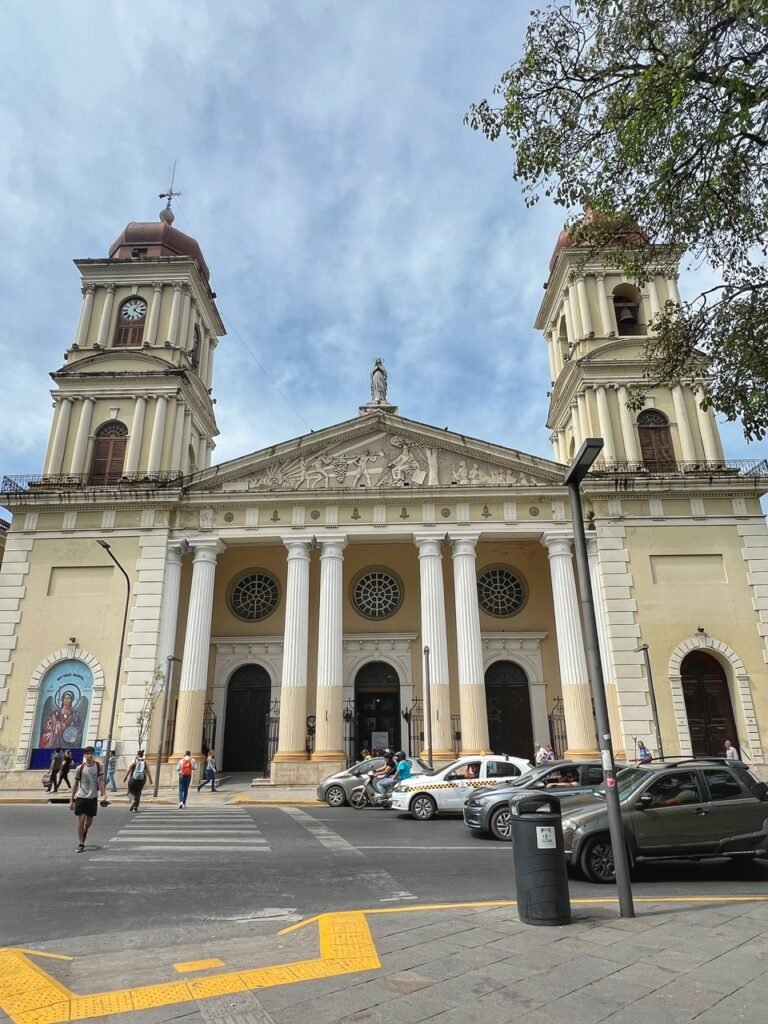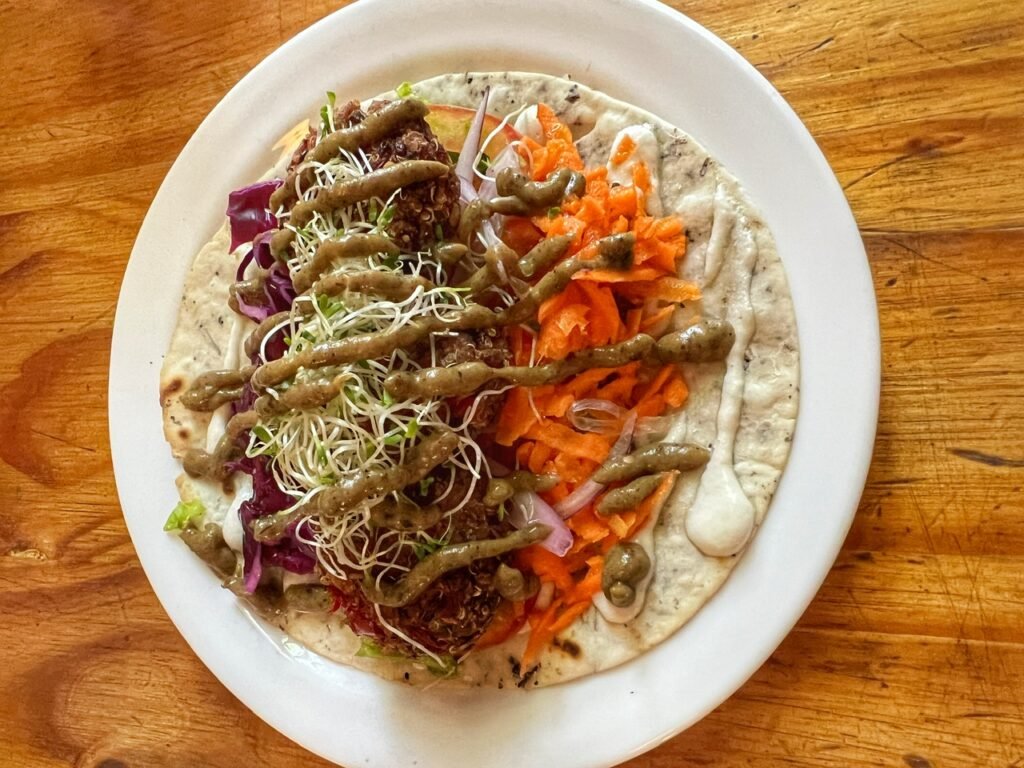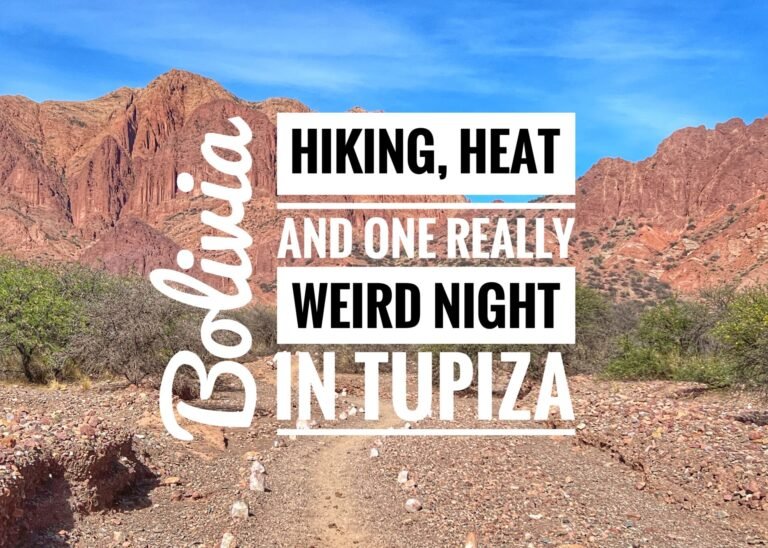
San Miguel de Tucamán
From Cafayate, we bounded 6.5 hours southeast by jumbo bus through some luscious green temperate rain forest, which felt like a complete godsend after over a month without, to San Miguel de Tucumán. ($11.50/each). The city is thankfully nicknamed Tucumán and not San Miguel because based on previous experience, we really don’t like places named San Miguel. This city, mostly known as being the place where Argentina gained independence from Spain, was the perfect pausing point en route to Córdoba. We also scored a fifth story apartment overlooking a main plaza with a 16th rooftop pool, which was a bit dirty, but it’s the thought that counts, right?! 🤣

The endless picture perfect vineyards as we rolled out of Cafayate.


Sweet water! How we’ve missed you! We couldn’t believe how drastically the landscape shifted in a few hours. It was very easy on the eyes (and the new developing wrinkles).


Arriving exhausted to our studio apartment in Tucaman at 9 pm. How is it that 7 hours on a bus makes you so tired?! 🤣 We immediately crammed our laundry into our first washing machine in a few days so we could get it drying in time for our two night stay. Considering the sun, that wasn’t an issue for the record. The beautiful Jacaranda and Palm tree-filled park outside our balcony made it feel like we’re in the Central Park of Argentina.



The slightly green rooftop pool. Meh. That’s disappointing. And, the gym which we’ll never use because there’s a beautiful park outside the building to run in instead. But still worth going up for because the 16th floor view looks a wee bit different than the 5th!
Going on the next morning, we realized how interesting it is when you arrive to Tucumán because suddenly the demographic is a lot more diverse, like in Buenos Aires, than we had been experiencing in the northwest. Suddenly we weren’t being targeted for “cambio, cambio” because our snowflakiness once again blended in with everyone else’s.
Thus, it took awhile to actually find the cambio guys on Calle Gral. José de San Martín, Tucumán to cash in our final crisp $50 bill on a day when the blue dollar rate was particularly beneficial for us, giving us 930 pesos for the dollar. We later found out that we should have got 970, which is how quickly it fluctuates.
One thing to note is that we hadn’t found official money changers since we left Buenos Aires at the end of September (2023). The only options were maté-drinking guys with massive bags of cash on the sides of the streets, who immediately get googly-eyed over a Grant or Benjamin, or Western Union which is now charging a $15.99 fee to get money when there was no fee before. And today, just prior to the election on Sunday, inflation is nearing 150% Clearly it’s hard to keep up in Argentina….

Although we didn’t take photos of the money guys, some other shots of the city follow. This is the governor’s art nouveau palace for the state of Tucaman. Although you’ve probably never heard of it, Tucumán, founded in 1565, is the fifth largest city in Argentina.

And it also appears a bit progressive While walking through the center, we heard a parade of honking horns celebrating this young lady. Not her marriage, but her fresh doctoral status.


People will likely need her if they’re eating like this. And dang, again it’s so hard to resist in Argentina. Our selection was two mouth-watering different types of alfajores, their national cookie, both stuffed with creamy dulce de leche for $1.86.

Fortunately, they also have one of the best vegetarian buffets we’ve been to, maybe ever, called Shitake to balance it out.


The selection was unbelievable, particularly their protein bar of quinoa, black bean and other grain/legume cakes topped with culinary care. And all this was about $8.50. Particularly interesting was Mandy’s salad “pie” in the top left corner. Something bizarre about eating out in Argentina? You’ll rarely find a salt shaker on the table because in 2012 the health department made it illegal to combat the growing number of people with hypertension. (1/4 of the population.)


An artisan market and one of the main pedestrian walkways


The Casa de la Independencia, where Argentina gained independence in 1816 from Spain, and the courtyard of the Casa de la Independencia.

Tucumán was part of the Inca empire in the late 15th and early 16th centuries, but by the late 1500s the Spanish had colonized the piedmont with the intent of raising agricultural produce for the silver-mining centre of Potosí (Bolivia), which lay in the high Andes, 500 miles (800 km) to the north.


And the official room where Argentina shoved it to Spain. But, we couldn’t get close enough to the table to see if anyone had carved “bite me, Spain” on it.

We did, however, get a nice photo of this lady with her new soldier boyfriend standing outside.

Overall Tucumán was a very livable and comfortable city, just like all the ones we’ve been to in the country.


The main cathedral in the Plaza de Independencia was not too showy.


Another church receiving a nursery-hued makeover. But, compared to Salta, the colonial charm doesn’t even compete.
Altagracia

Around this time, we headed to Cordoba for a quick overnight and picked up a couple cute hitchhikers, who kindly also provided the wheels, at the Córdoba Airport. That’s right, we were so happy Greg’s parents, Larry and Grace, were FINALLY traveling with us again after a very long COVID travel drought! 🙂
Our first stop 45 minutes south of Cordoba, was to the town of Altagracia, boyhood home of Ernesto “Che” Guevara. Before he became a popular Marxist rebel and prominent figure in the Cuban Revolution (1956–59), his family moved him here in 1935 because he was struggling with asthma.
Altagracia is also home to a university and church built by 17th Century Jesuit missionaries, and the first of many restaurant and ice cream stops we would make on this road trip. It’s definitely a charming town tucked into the Central Sierra Mountains for a stopover.

Alta Gracia is one of Córdoba provinces’ World Heritage sites.


Stopping for lunch at El Ferroviario, or the old railway station. The birthday boy diving into his first Milanesa. Larry turned 78 years young the day before we picked him up!


Grace and Mandy settled for shrimp and salmon salads. And some strange pickled fish-like substance to spread on the bread. We later found out that the fish-like substance we’d put in our mouths was actually…cow brains. 🤢 Not cool. Not at all cool.

This photo was taken before Mandy found out this information. She turned the color of the emoji afterwards. Other than that, the food was great and cost $33 for the four of us including a bottle of Sauvignon Blanc.

The inside of the former railway station

From there we walked six minutes to the former home of little Ernesto. He looks a bit resolute even in his kid statue…

A very famous motorcycle, particularly if you’ve seen or read “The Motorcycle Diaries.” If you haven’t, this autobiography is about Che’s journey across South America on a break before his last semester from medical school.


Che’s childhood bedroom, as well as a photo with his family

The kitchen was referred to as the “wood stove” because of the innovative system to obtain hot water for the house. Ernestito used to spend time in this room using aromatic herbs when his asthma attacks kept him from leaving the house.



The outside of the home.

There were some beautiful and very unique old homes walking around this neighborhood.


Alongside the square in Alta Gracia. The City of Alta Gracia was built around its famous Jesuit L-shaped estancia, which lies opposite the main square, and is now a museum. The Jesuits arrived to what is now Argentina in 1585. The Jesuits established large estancias, or ranches, in the countryside surrounding Córdoba.


These estancias each were large estates where farming, light manufacturing (often of textiles) and cattle-raising activities surrounded a central core that included a church, a priests’ residence and farmhouses for slaves and indigenous peoples. Slaves worked the land, usually for no wages, while the indigenous population often included artisans who were paid wages.
These rural estancias provided the funds for the Jesuit church and educational institutions in the city of Córdoba. This arrangement was to endure for 150 years until the Jesuits were expelled from Spanish America in 1767 by order of King Charles III of Spain. They were seen as a threat to royal power, particularly politically. (Intl Travel News.)

The Torre de Tajamar represents 450 years of history and reminded us of clock towers we’ve seen in rural France. The lofted archways of the former residential area.

Royalty at its finest.


Our photographer has arrived 😍


The main square of Alta Gracia, which of course we had to enjoy with gelato in hand.

The chicas at the ice cream shop.

In addition to being the town name, Atlagracia (which means High Grace) also happens to be Grace’s real full name, after her great grandmother who was Mexican. It’s really fun to experience Grace in her Spanish-speaking element.
Córdoba
Argentina’s second biggest city of Córdoba with a population of around 1.9 million was kind of a “mini” version of Buenos Aires. It is largely a university city with 200,000 students. Among those are the first to have been founded in Argentina, and the fourth oldest in America founded in 1613. The cafe and music culture is vibrant and the restaurant selection terrific. And although we only had a couple nights, we definitely appreciated the small taste we dove into.

The Rueda Eiffel, or Eiffel Wheel, was created in by Gustav Eiffel and is an icon of Córdoba and Paraue Sarmiento. As of this year, they started spinning it again after 20 years of it sitting in the dust. It begins every night starting at 8 pm, but it’s merely to gaze at. Definitely don’t think anyone would wanna jump onboard!

The main cathedral of Cordoba dates from the 16th Century.

The Hombre Urbano inaugurated in 1999 is an eye catching piece of urban art in the middle of a roundabout. To us, it looks like a guy who prefers walking over any form of transportation but according to the artist, the urban man “runs into the future leaving behind the century with his great discoveries, with technology, with computers, with airplanes, the railroads, industries, automobiles and enters the third millennium.”

Like in Buenos Aires, the fruit and veggie selection is off the charts for cost and quality. If you are interested in prices, zoom in. We are currently exchanging $1 for 970 pesos. This makes a kilo (2 lbs) of red peppers about $1.25 for example.

Cordoba is also saturated with amazing craft beer, including this “bike” bar which seems like it fell out of our old home in Portland, Oregon.

Enjoying the view at Parque Sarmiento, a beautifully landscaped and lush park near the urban man.

The park includes a massive Great Gatsby looking pool, which was clearly not open even though it was well into summer temperatures.


Another perk of Córdoba was that they rented free bicycles for anyone! And parts of it were definitely made for bicycles and pedestrians!

The tower of the main cathedral where we started our free walking tour. It took 200 years to finish this church because they didn’t have enough Spanish architects available to do so.



The mosaic masterpiece on the floor inside, and of course stained glass as well. But the real icon is the soaring dome, which is an emblem for the city.

We learned on our free walking tour that in front of many buildings in Córdoba lies a silhouette style sketch of the building looming overhead. Evidently, the artist/architect who made them (who sounds like he has too much time on his hands) was disheartened that when people walked around they looked at the ground, so this forced them to at least “look” at the building. 🤣

The Cordoba Museum of Memory is devoted to those 30,000+ people that “went missing,” or desaparecido during the military dictatorships in the mid to late 20th Century. Many of them were pregnant women whose children got taken and raised by families of the dictatorship. Today, there is a large group of grandmothers who are trying to reunite with these children with DNA testing. It’s a tragic story but leading to a happier ending.

It wouldn’t be a walking tour in Argentina without a stop to taste test the local alfajor. Alfajores are cookies typically stuffed with dulce de leche inside, but most provinces in the country offer a slightly different variety. The sinning never ends in Argentina. 😁

There were many pedestrian walkways throughout the center which of course we loved.

What looks like a standard subway tunnel (which Cordoba doesn’t have) leads to a bizarre underground offering in the form of recently discovered (1989) Jesuit crypt which dates back to the early 18th Century. It is likely the site of where the Jesuit church was supposed to be built atop it, but with the expulsion of the Jesuits, it was never finished.

The French architecture, like in Buenos Aires, is also prevalent, but the overall feel is definitely less Parisian.

Considered the narrowest building in South America, this cheese chunk of a building, called “The Global Building”, is only three meters wide and currently houses two families. The peculiar construction arose as a result of a dispute between owners of neighboring land. The owner of the neighboring land tried to buy the demolished part of the construction as a result of street construction at a low cost, but the original owner resisted and decided to erect an awkward building instead. Sounds like another spite house.

The flag which represents the state of Cordoba.

Argentinians take education seriously. This prestigious high school teaches a whopping 8 languages: Spanish, English, French, Greek, Latin, Portuguese, Chinese and Russian. Also, all universities are free so nearly everyone goes. However, the programs are rigorous and long so only about 10% graduate.

Our guide, Aldi, revealed to us that she was definitely one that didn’t.

After the tour, we grabbed food at an Arabic restaurant which was a very nice change of pace with hummus, baba Ghanoush, stuffed grape leaves, and lots of meaty concoctions. All this cost about $12 for the four of us.


To balance out the carnivorous offerings, the next day we grabbed some delicious vegan food at Alma Casa Vegana. The meal included an absolutely delicious almond milk Frappuccino which like most things was about a $1.

A beautiful bank building.



Cordoba also has lots of trendy eateries like this food court, which is where we snagged our Thanksgiving feast of a sushi platter, coconut shrimp and a coconut brownie topped with ice cream and passion fruit. Absolutely incredible for here! Grace also managed to grab a photo of the crew at Tokin Sushi.

Our fancy pants 13th floor room at Y11 Hotel.



It included a rooftop lounge, a rooftop pool, and an unbelievable breakfast spread. Two rooms cost Greg’s parents about $80/night with the exchange rate at the time. Yes, we certainly enjoyed our Christmas gift from los padres😊



